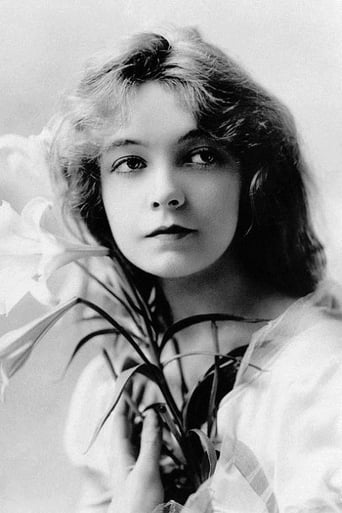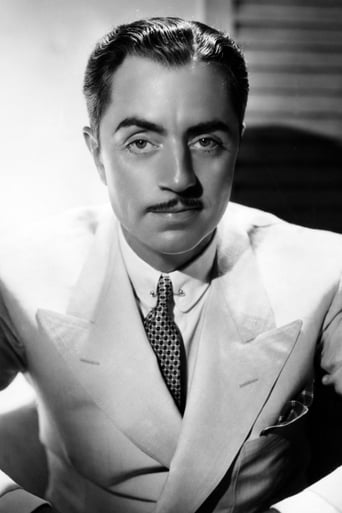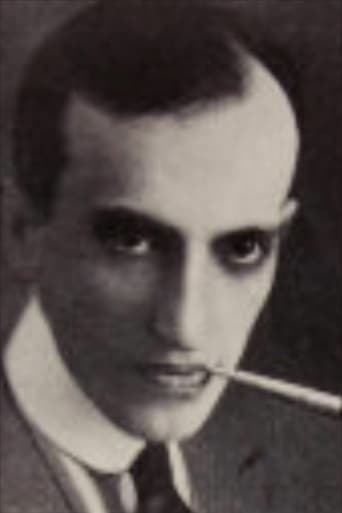Tacticalin
An absolute waste of money
Onlinewsma
Absolutely Brilliant!
Humbersi
The first must-see film of the year.
Cheryl
A clunky actioner with a handful of cool moments.
GManfred
Period piece based on the novel by George Eliot. And what a period piece it is! MGM must have spent a ton of money recreating the costumes, atmosphere and architecture of 15th century Florence. The detail is meticulous and lends the feeling of a modern production taking place 6 centuries ago. I have not read the book but I wonder if it reads better than it translates to the big screen. The film is long - longer than most films of the silent era, and at times tends toward tedium. In fact, it is downright dull in spots, and those spots overtake those of interest. Makes you think it could have a used a little heavier hand in the cutting room. The cast is excellent, and once again William Powell plays the villain of the piece and steals the show. The Gish sisters never looked more attractive, especially Dorothy. Ronald Colman was stalwart but overshadowed by Powell. On whole, it is entertaining and sumptuously mounted but be aware of above-mentioned lapses in the narrative.7/10 - The website no longer prints my star rating.
Steffi_P
Adaptations of novels made up a large proportion of motion pictures in the 20s, as the medium of cinema began to see itself as continually more prestigious and legitimate. The trouble is they were still figuring things out when it came to translating from one narrative form to another. Romola is taken from a novel by the brilliant 19th century author George Elliot, and her work is typically rich in character detail and interwoven subplot. However this movie version pares the story down to a basic melodrama, with a handful of simple characters flitting from one plot point to the next. As if to compensate, the action is peppered with lengthy title cards, which while they preserve little snatches of the original text, break up the flow of visual storytelling.But all is not lost. The language of images was well developed in Hollywood. Romola's director is Henry King – not a well-remembered figure, although he ought to be. King's shots are consistently stylish, and he has a good handling of space and framing. Take for example when Dorothy Gish is abandoned amid the festivities after her sham wedding. We see a close-up of her, distraught, while the dancing revellers around her make a wild, blurry backdrop – far more effective than some expressionistic process shot, because it is realistic as well as evocative of mood. But what was really King's greatest strength at this point was the slow, methodical performing he encouraged from his cast. It is this that really brings out all those layers of character that are missing from the screenplay. Look at the scene in which Lillian Gish gives the ring to her father to examine. The camera is simply held in mid-shot as the old man turns it over in his hands, and so much more comes out of that moment as a result. And the strength of the mise-en-scene is proved as for some key scenes those pesky intertitles disappear altogether – such as when Powell proposes to Lillian. It's a pity so few directors these days are bold enough to simply performances play out like that.And this approach really suits star Lillian Gish. After parting ways with her old mentor D.W. Griffith she briefly formed a production company with King and, while it's rarely acknowledged, she did some of her best work with in their handful of pictures together. In an age when overt mugging and gesture were the norm, Gish is beautifully subtle, the emotions drifting across her face like clouds across the sun. The villainous turn from William Powell is also nicely understated. Powell is probably better remembered for the series of jolly father-figures he played in the sound era, but as a young man his thin lips and piercing eyes marked him down a bad guy. But here he refuses to live up to the stereotype, portraying Tito as a villain by his deeds and not by his mannerisms. There are some nice touches from even the smallest parts in Romola, and it is generally very well cast. The only disappointment is ironically Gish's younger sister Dorothy, who up to this point had mainly been confined to comedy shorts. She seems never to have learnt the subtlety that Lillian mastered, and for someone designated a comedienne she isn't actually very good at being funny either.There was never really much hope that this production could capture the depth or sensitivity of a George Elliot novel, but it at least has a grace of its own that is very cinematic. If its makers had only cut down further on text and allowed the images and performers even more free reign, they would have moved it further from text-based narrative but they would also have captured just a little more of the spirit of the original. After all, well-written prose should conjure up strong images in the mind of a reader, and visual storytelling is not necessarily contrary to telling stories with words.
rdjeffers
"He is the traitor of traitors -- the liar of liars --"A mysterious stranger appears in 15th Century Florence and overturns the apple cart. Tito (William Powell) presents an outward appeal that does not reveal his Machiavellian intentions, as he charms his way into Florentine society.In her second film with director Henry King, Lillian Gish was cast as the title character and moral compass of George Eliot's mid-Victorian novel, a tale of social, cultural and religious upheaval set in Renaissance Italy. Sister Dorothy once again played a mirror opposite, the dark-eyed, simple-minded street urchin Tessa, who virtually steals the show. Considered a "prestige" film by it's newly incorporated distributor MGM, Romola made extensive use of exceptionally beautiful locations in and around Florence, with flocks of birds and a host of eager, well costumed Italian extras, masterfully arranged and photographed by King. The oddly altered scenario, typical of Hollywood, is a staid but entertaining reinterpretation of Eliot's Bonfire of The Vanities.Notes on the noteworthy…Tessa's introduction is particularly lovely, as Tito wakes her with a kiss on the nose. They later share a beautiful scene on the banks of the Arno with the Ponte Vecchio in the background. While Eliot incorporated actual events into her novel, this fast and loose re-write may confuse history buffs. Without giving away too much, it seems screenwriter Will M. Ritchey has juggled the idea of several events, while significantly altered, to create a spectacular ending. King went to great lengths, making full use of the location, from expertly framed scenes with the Duomo prominently displayed as the background, to numerous side streets and country lanes. One shot of a large crowd passing through an arch with the dome behind them as a flock of birds fly past overhead is absolutely breathtaking!
theowinthrop
People watching his comic performances, or his detective roles first as Philo Vance and then as Nick Charles, rarely think of William Powell as anything but a terrific actor in talkies, who happened to be good in comedy, mystery, and drama be he married to his screen partner Myrna Loy or Mr. Day Sr. in LIFE WITH FATHER. Most don't realize, though, that Powell had a film career in silent movies. And there, he was not a nice fellow at all - he was usually the villain. Most notably in the first film version of BEAU GESTE (he played the "snitch" character played by J. Carroll Naish in the 1939 classic) and this film, one of the last silent movies starring Dorothy Gish as well as her better remembered sister Lillian. As Tito Melema, the power-hungry opportunist (and coward) in ROMOLA he shows the darker side of his acting craft - and it is of interest to catch the film for that reason alone.ROMOLA is unique - it is one of the seven novels that were written by Ms Mary Ann Cross, better known as "George Eliot". In discussing Eliot's novel turned to film, THE MILL ON THE FLOSS I pointed out that her's was one of the best intellects of the Victorian period, and her novels are well regarded by critics but not read as much as say Dickens, the Brontes, or Trollope (or even Thackeray). The reason is she has one of the most difficult writing styles to plow through. It is easiest to read her shortest novel, SILAS MARNER, but after that you are on your own. Still it can be rewarding - MIDDLEMARCH, her longest and best novel, was called the most grown-up novel in the English language by Virginia Woolf.Most of her novels are set in England. ROMOLA is the only one that is set abroad - in Renaissance Italy in the city state of Florence. The novel deals with the city of Florence from 1491 (the death of Lorenzino "the Magnificent" De Medici) to 1498. The story describes how the city was taken over from 1494 to 1498 by a group of puritanical reformers led by a Dominican friar named Girolamo Savanarola. Savanarola's "reform" period in Florence has been subject to much controversy. Certainly there were grounds for serious reform in politics and in religion. His supporters (who still exist) feel Girolamo's problem was he showed up on the scene twenty or thirty years prematurely - that if he had been in power in 1517 or 1521 he would have been able to coordinate his ideas with those of Martin Luther, his Northern German counterpart. But Luther wanted to do things with Christianity that Savanarola never did. Luther wanted everyone to read the Bible, and wanted priests to be able to marry. Savanarola never said he wanted those reforms. He wanted the people to obey Biblical rules, and felt the Roman Catholic Clergy should make sure this happened. Moral reform, not structural was his goal.And since it was moral reform, his actual achievement (cleaning shop in Florence) made more enemies than he could afford. Most of the citizens of Florence begrudgingly went along, because of the threat of death if they did not. And the Medicis (forced into temporary exile) were not pleased at being chased out of their city and property. The worst set of enemies were the Roman Curia (then under Pope Alexander VI (Roderigo Borgia). Possibly the most corrupt Pope in history, Borgia had no desire to see a successful reformer in Florence. When one of the leading junior members of Savanarola's clique made comments suggesting he and Savanarola could perform miracles, Borgia saw his opportunity. He first excommunicated the reformers, and then tried Savanarola and his leading supporters for heresy. On May 23, 1498 the three men were burned to death. It later was told that Savanarola gave a prediction of horrors due to warfare that would befall Florence in 1529 during the papacy of some man named Clement. Pope Clement (who happened to be of the Medici family) was on the papal throne in 1529, when Florence was under attack.This is the background of the novel, following Tito's latching onto the reforming monk's coat-tales for his own aggrandizement. Although married to Tessa (Dorothy Gish) Tito tries to have his way with Romola (Lilian Gish). As the monk falls from power, Tito's real character is revealed. Romola is saved by her lover Carlo (Ronald Colman). I will only add that the unfortunate Tessa is not that lucky.






